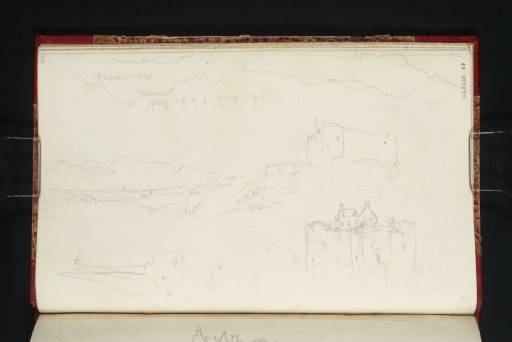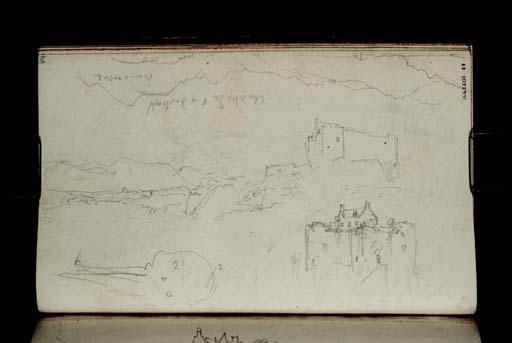J.M.W. Turner
>
1830-35 Annual tourist
>
Scotland 1831
>
Staffa Sketchbook
>
Artwork
Joseph Mallord William Turner Sketches of Dunstaffnage Castle; Ben Cruachan from Dunstaffnage; and a Wrecked Boat 1831
Image 1 of 2
Joseph Mallord William Turner,
Sketches of Dunstaffnage Castle; Ben Cruachan from Dunstaffnage; and a Wrecked Boat
1831
Joseph Mallord William Turner 1775–1851
Folio 89 Recto:
Sketches of Dunstaffnage Castle; Ben Cruachan from Dunstaffnage; and a Wrecked Boat 1831
D26916
Turner Bequest CCLXXIII 89
Turner Bequest CCLXXIII 89
Pencil on white wove paper, 116 x 186 mm
Inscribed in pencil by Turner ‘Behind the G[...] v Dunstaff’ and ‘Ben Cruachan’ top-left inverted, ‘6’ ‘2’ ‘2’ around the diagram at the bottom left
Inscribed in blue ink by John Ruskin ‘89’ top left running vertically
Stamped in black ‘CCLXXIII 89’ top right running vertically
Inscribed in pencil by Turner ‘Behind the G[...] v Dunstaff’ and ‘Ben Cruachan’ top-left inverted, ‘6’ ‘2’ ‘2’ around the diagram at the bottom left
Inscribed in blue ink by John Ruskin ‘89’ top left running vertically
Stamped in black ‘CCLXXIII 89’ top right running vertically
Accepted by the nation as part of the Turner Bequest 1856
References
1909
A.J. Finberg, A Complete Inventory of the Drawings of the Turner Bequest, London 1909, vol.II, p.878, CCLXXIII 89, as ‘Dunstaffnage Castle. See Engraving, Scott’s Prose Works 1836.’.
1982
Francesca Irwin, Andrew Wilton, Gerald Finley and others, Turner in Scotland, exhibition catalogue, Aberdeen Art Gallery and Museum 1982, p.54 under cat.74.
1991
David Wallace-Hadrill and Janet Carolan, ‘Turner in Argyll in 1831: Inveraray to Oban’, Turner Studies, vol. 11, no.1, Summer 1991, p.29.
1997
Martin F. Krause, Turner in Indianapolis: The Pantzer Collection of Drawings and Watercolors by J.M.W. Turner and his Contemporaries at the Indianapolis Museum of Art, Indianapolis 1997, p.182 under cat.55.
Although Turner had not been commissioned to sketch Dunstaffnage Castle for Sir Walter Scott’s Poetical Works (the project that brought him to Scotland in 1831), he took a great interest in the ruin, making numerous sketches from a distance and close by. These proved useful when he was commissioned to make a watercolour of Dunstaffnage circa 1832–5 (Indianapolis Museum of Art),1 to be engraved for volume 24 of Sir Walter Scott’s Prose Works.
Turner visited the castle on his way to Oban via Loch Etive. As he approached it from the loch to the east he made a number of sketches on folios 80 verso–83 verso, 84 verso and 86 (D26899–D26905, D26907, D26910). On reaching the castle he entered its grounds and made studies of the ruins from the vicinity: folios 87–89 verso (D26912–D26917), before circling the castle more widely to make sketches from various directions: folios 90, 91–93, 94 (D26918, D26920–D26924, D26926), 98 and 97 verso (D26932, D26935; CCLXXIII 97, 98a). Turner also took the opportunity on a later occasion to sketch the castle as he passed it on his journey to Fort William: folio 39 verso (D26816).
This page contains three sketches of the castle and a separate diagrammatical sketch. The most significant is the sketch across the centre of the page (with the fore-edge at the top). This is the drawing that Andrew Wilton and others have identified as the study for Turner’s watercolour.2 It shows a view of the castle from the west, made from a few hundred metres away near the edge of the promontory at the mouth of Loch Etive. In the distance to the left of the castle are the mountains to the north of Loch Etive. The sketch resembles the composition of the watercolour with the castle on its rock at the right, the water of Loch Linnhe to the left and mountains in the distance. The watercolour, however, in fact shows the castle from the north-west, a view that is depicted on the reverse of this page (folio 89 verso), but which has a similar composition. Turner must have referred to a number of his sketches for different details when he came to make his watercolour.
At the bottom right of the page is another study of the castle. This view is from the south-east and was, like the sketch on folio 88, probably made from the beach near the castle. Its shows the curtain wall with cylindrical towers at its corners and the roof and top floor of the gatehouse above. While the sketch is fairly rough, Turner took care to indicate architectural details such as the crow-stepped gables and windows, as well as the arched doorway in the east wall.
Along the fore-edge of the page, with the sketchbook inverted, is a view of mountain profiles inscribed ‘v[iew] of Dunstaff[nage]’ with the mountain at the right labelled ‘Ben Cruachan’. Rather than a view of the castle, this is the view beyond the castle, as may be indicated by the rest of the inscription (?‘behind the [...]’). We are therefore looking east from the castle towards the mountains either side of Loch Etive. The wave-shaped peak of Ben Cruachan is at the right, and at the left is the peak of Beinn Mheadhonach. Turner may have referred to this sketch to paint the mountainous background of Dunstaffnage, although it would have acted as an inspiration rather than a model, the shape of the peaks being quite different in the watercolour.
The final drawing at the bottom left of the page is a diagram of the prow and keel of a wrecked rowing boat. Although the schematic sketch is rather obscure, the same shape can be seen in a drawing on folio 88, where it appears alongside an intact rowing boat in a view of the beach to the south-east of Dunstaffnage Castle. The numbers inscribed on the sketch, ‘6’, ‘ 2’ and ‘2’, are probably measurements of its different parts in feet.
Thomas Ardill
January 2010
How to cite
Thomas Ardill, ‘Sketches of Dunstaffnage Castle; Ben Cruachan from Dunstaffnage; and a Wrecked Boat 1831 by Joseph Mallord William Turner’, catalogue entry, January 2010, in David Blayney Brown (ed.), J.M.W. Turner: Sketchbooks, Drawings and Watercolours, Tate Research Publication, December 2012, https://www


